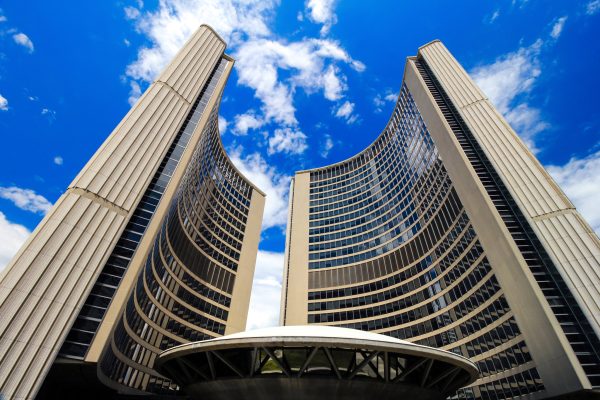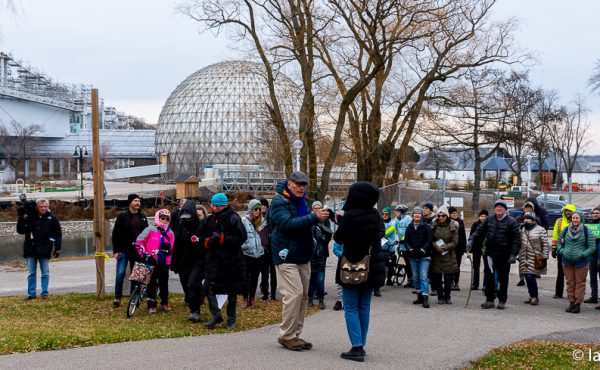Here’s an interesting chronological footnote about this week’s much-hyped GTA-wide “One Fare” integration announcement, which will allow commuters from 905 municipalities to transfer onto both Metrolinx lines and TTC routes free of charge and cost $117 million per year.
Had the assembled VIPs — Premier Doug Ford, Mayor Olivia Chow, TTC chair Jamal Meyers and associate transportation minister Vijay Thanigasalam — waited for merely another six weeks to cut this particular ribbon, they could have also celebrated the twentieth anniversary of GTA-wide fare integration as a formal policy goal of, well, everyone.
In late March, 2004, Mayor David Miller, Premier Dalton McGuinty and Prime Minister Paul Martin converged for a presser at the Hillcrest TTC Yards to unveil a tri-level $1 billion transit plan which included $140 million for a smart-card based fare system that would allow riders to travel across GTA municipal borders, as well as cash for bus rapid transit.
It took us 20 years, plus hundreds of millions wasted on Presto fare card consultants, to get to One Fare — a generation.
A few other examples: the massive reconstruction of the new mouth of the Don River, through the Port Lands, was first announced in 2007 as the winner of a Waterfront Toronto design competition, and is finally now sufficiently built out that water is being pumped into the man-made river channel. Seventeen years, plus a lot of political wrangling, not least an attempt by Doug Ford to completely derail the plan.
The Scarborough busway, upon which the Chow administration has bestowed funding, is the work-around to a work-around to the Scarborough-Malvern LRT, which was announced, approved and funded as of December, 2009, and then summarily executed by the premier’s late brother a year later, ostensibly in the name of Scarborough commuters who won’t be boarding rapid transit in that part of the city until 2030-ish, with the busway coming online only around 2027.
Also 20 years.
Rome, as the wise old adage goes, wasn’t built in a day, and Toronto won’t be, either. But as the politics of post-pandemic planning increasingly focuses on finding ways to accelerate the pace of housing construction, it seems to me this region needs to have a frank conversation with itself about its compulsion to slow-walk all manner of infrastructure projects.
One reason why Chow has made such a deep impression right across the political landscape is that she’s emerged as a doer of the first order — a leader animated by a desire to clear away roadblocks instead of erect more of them. It feels like she’s delivering a master class in politics as the art of the possible.
Chow also stands out because she’s such an anomaly. Many more of our policy-makers need to figure out how to internalize her practical approach and short-circuit what has become an extraordinarily expensive approach to city-building — one that has, I’d argue, exacerbated our housing woes.
Our self-inflicted problems aren’t merely the result of inter-governmental sparring, policy reversals following elections, lead-footed bureaucrats, economic ups and downs, etc. Every big city faces precisely this constellation of pressures, yet not every city is so adept at getting in its own way.
Nor was Toronto always as plodding as it’s been in recent decades. The bulk of the TTC’s first subway routes — 69 stations! — were built between 1949 and 1966, 17 years. Hundreds of large apartment buildings went up around the city between the late 1950s and the late 1970s. The wholesale transformation of the industrialized downtown and the rail yards — same story, similar pace.
I used to think that structural governance reform could provide a more streamlined approach to activities like transit development, with fewer trip wires, less political interference, more evidence-based decision-making, etc. But as the case of Metrolinx so vividly demonstrates, the notion of creating a government agency that is somehow insulated from, well, government, has turned out to be magical thinking.
The GTA’s incoherent municipal system is certainly a structural governance failing that incentivizes policy arbitrage and re-litigation; the recent about-face on the Hurontario LRT extension into Brampton is a pretty good example of how inter-governmental partisanship can turn an entirely rationale plan into a game of political pickle ball.
The compulsion to re-litigate earlier decisions, often in the name of fiscal probity, is perhaps the most pernicious source of our inability to get important stuff done, but this habit is, in my view, a cultural problem, not a structural one. By cultural, I mean political culture, which is to say the culture of public discourse and decision-making, both of which encompass a huge variety of stakeholders but often a rather narrow set of parameters.
I suspect no one’s ever done a GTA-wide tally from, say, the Mike Harris municipal reforms, of the total delay-related costs to projects that ended up getting built despite all the re-litigating. I’d bet that number is eye-wateringly large, and now sits like a boulder on the balance sheets of our various local governments in the form of unnecessarily enlarged debt.
Ironically, those expensive delays are often brought about by calls from the right — e.g., Stephen Holyday’s efforts at council this week to hold up the city’s bus rapid transit plan — for greater precision in costing. By now, we all know how the math works, and yet some of the participants in this game run the same play over and over.
Another source of delay-culture: the seemingly inviolate budgetary principle that growth should pay for growth. The City has dozens of reserve funds that accumulate cash bit by bit. These financial receptacles, into which flow development charges revenue, are supposed to pay for nice things — a new ferry! more transit! — and they also provide the city with a cushion when the operating budget craters.
It’s increasingly clear that the premise behind growth-pays-for-growth is flawed, because it institutionalizes the delay of big projects, which ensures they will not only cost as much as possible, but become much more difficult to build. I’m hoping the Chow administration will bring some fresh and long overdue thinking to this approach to funding infrastructure.
The Queen’s Quay LRT is a prime example. When we finally have enough loonies in the municipal cookie jar, much of the waterfront/port lands development will have happened, meaning the LRT construction must compete with the area’s new residents, who will be driving far more than they should be because, well, growth pays for growth so there’s no LRT.
In this case, the growth-pays-for-growth approach will translate into more condos with on-site parking, and thus more cost, more emissions, more embodied carbon, etc. Needless to add, the all-in cost of building a Queen’s Quay LRT today — i.e., the interest charges on the bonds — will be far less than when the political stars align at some future date to approve the funding for what will then be a much more expensive undertaking. But hey, we saved money, right? Wrong.
I’m not arguing here for a damn-the-torpedos approach. Governments need to do their due diligence, but perhaps they don’t need to do their due diligence five times. I realize it is asking a lot, but more self-awareness on the part of our decision-makers would be a welcome change.
Perhaps the thing that could wake them up to the vicious cycle in which we find ourselves is a clear-eyed recognition of the relationship between endlessly delayed infrastructure and a housing system that moves with all the speed and agility of a snapping turtle. The molten pace of rapid transit construction has helped throttled development and intensification.
I absolutely believe it’s possible to build a city at a pace that finds some balance between excessive haste and oppressive dawdling. We did that after Metro was formed in 1954, and we can it again in 2024. But to find that groove, the folks in power need to be asking themselves every day, `Will my choices today help drive generation-long delays?’
Chow is showing both voters and the political classes how to get stuff done quickly but not carelessly. Here’s hoping her refreshingly impatient pragmatism will be contagious in a city-region that had forgotten how to get to yes.






One comment
Will have to make a study be answering. Have to find the funds to do the study first.